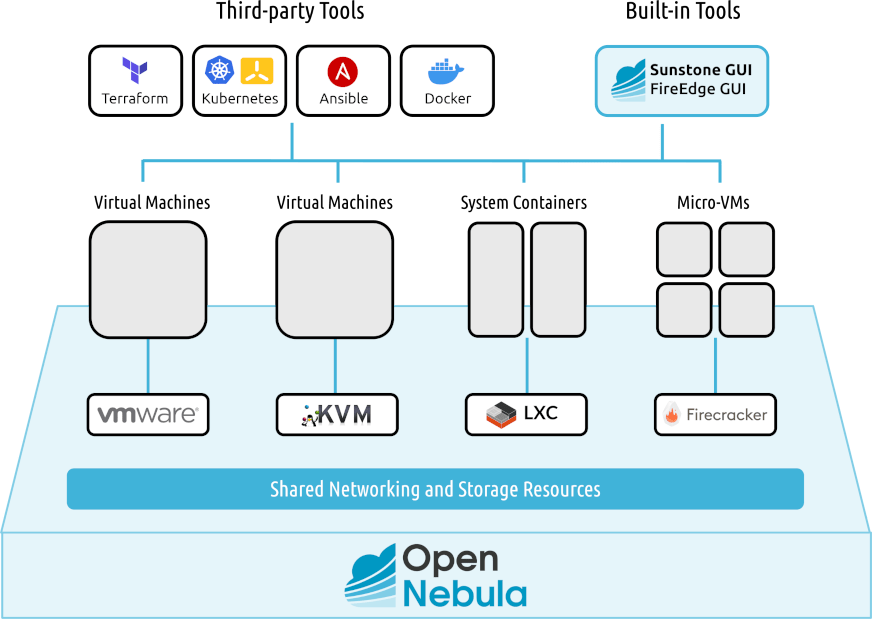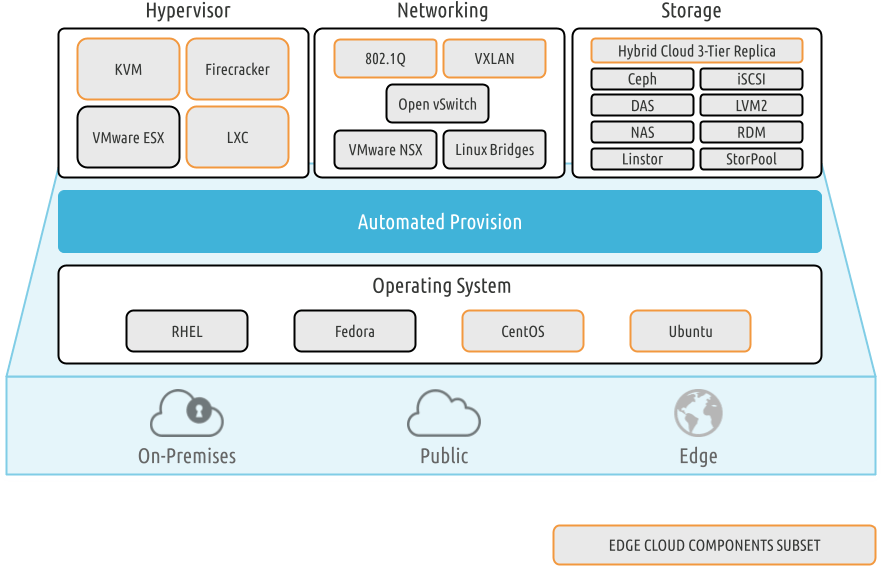OpenNebula
 The Open Source Cloud & Edge Computing Platform
The Open Source Cloud & Edge Computing Platform
Get Started with the New OpenNebula 6.8
Enterprise Backup Efficiency
Advanced Virtualization Capabilities
Improved GUI User Experience
If you are looking for a powerful, but easy-to-use, open source platform for your enterprise private, hybrid or edge cloud infrastructure, you are at the right place.
Welcome to OpenNebula, the Cloud & Edge Computing Platform that unifies public cloud simplicity and agility with private cloud performance, security and control. OpenNebula brings flexibility, scalability, simplicity, and vendor independence to support the growing needs of your developers and DevOps practices.
One Unified Platform to Run Applications and Process Data Anywhere
- Any Application: Automate operations and manage VMs and Kubernetes clusters on a single shared environment
- Any Infrastructure: Open cloud architecture to orchestrate compute, storage, and networking driven by software
- Any Cloud: Combine private, public, and edge cloud operations under a single control panel and interoperable layer
OpenNebula 6.8 ‘Rosette’ is the fifth stable release of the OpenNebula 6 series. This new release comes packed with new functionality, mostly focused on improving the end-user experience as well as optimizing the use of the HW resources in KVM-based infrastructures.
Version 6.8 is packed with essential features and integrations tailored for streamlined maintenance, monitoring, and optimization of your enterprise cloud. Noteworthy additions include the Virtual Data Center (VDC) and User tab in your FireEdge Sunstone, the introduction of backup jobs for creating a unified backup policy across multiple VMs, along with several improvements in the KVM drivers.
OpenNebula 6.8 – Main New Features
- FireEdge Enhancements: Addition of Virtual Datacenter (VDC) & User Tab to FireEdge Sunstone, showcasing accounting & showback information
- Backup Jobs: Using Backup Jobs, you can now manage and monitor unified backup policies for multiple VMs efficiently
- Improved KVM Driver: With the updated KVM drivers, you can fine-tune CPU flags, optimize disks, customize VM video, & boost Windows performance
OpenNebula Benefits
- Power of Simplicity: A single control panel that unifies management across the hybrid multi-cloud continuum
- Lightweight and Easy to Maintain: Single enterprise-ready product, with small footprint, and a one-stop long-term commercial support
- Elastic and Fully Automated: Automated operations with deployment of clusters on-prem and on-cloud in < 5 minutes
- Vendor Neutral Flexibility: Infrastructure agnostic to build an enterprise cloud that meets your needs on-prem and on-cloud
- Proven and Scalable: Many large scale production deployments with thousands of distributed nodes
- Cost-effective: In 10-node cloud, reduce TCO by up to 75% compared to VMware and Red Hat OpenStack
OpenNebula combines virtualization and container technologies with multi-tenancy, automatic provision and elasticity to offer on-demand applications and services.
- It supports both containers with virtual machines in a common shared environment to get the best of both worlds.
- It integrates multiple virtualization technologies, from VMware and KVM for fully virtualized clouds to LXC and Firecracker for containerized and serverless deployments.
- It can easily deploy hybrid and edge environments with infrastructure resources from AWS, Google and Equinix.

A standard OpenNebula Cloud Architecture consists of the Cloud Management Cluster, with the Front-end node(s), and the Cloud Infrastructure, made of one or several workload Clusters. These can be located at multiple geographical locations, with different configurations and technologies to better meet your needs:
- Edge Clusters that can be automatically deployed both on premise and on public cloud or edge providers to enable true hybrid environments.
- Open Cloud Clusters based on certified combinations of open source hypervisors, storage and networking technologies.
- VMware Clusters that use existing VMware infrastructure.

OpenNebula is a fully open platform for organizing the management of cloud infrastructure and virtual environments. The package allows organizing the interaction of such attributes as storage, networking, virtualization technologies, monitoring and security management tools in order to create a distributed infrastructure of dynamically deployed multi-tier services (groups of interconnected virtual machines), combining the resources of the data center and external cloud services.
The system code is fully open source under the Apache license and is available to everyone without restrictions. Ready-to-use OpenNebula installation packages are available for Ubuntu 10.04, CentOS 5.5, Debian 5.0.6 and RHEL 5.
The system allows you to create Cloud-environments of three types:
- Private cloud-systems, available only within the organization, fully controlled and executed on its own facilities. Xen, KVM and VMware are supported as virtualization systems;
- Public cloud environments running on the infrastructure of external service providers such as Amazon EC2. To access public cloud environments, OpenNebula supports APIs such as EC2 Query, OGF OCCI and vCloud;
- Hybrid cloud systems that combine elements of public and private cloud systems. For example, a certain critical part of the infrastructure can operate in a private cloud, and secondary systems are moved to external clouds, or initially the entire system is built as a private, but when there is a lack of resources at peak times to work attracted to the capacity of public services.
Key capabilities:
For the infrastructure manager:
- Dynamically resize the physical infrastructure through adding or removing nodes on the fly and partitioning the cluster into virtual partitions, allowing only the amount of resources needed to run a particular service to be allocated;
- Centralized interface for managing all elements of virtual and physical distributed infrastructure;
- High degree of utilization of available resources, possibility to connect external resources, lease resources or organize infrastructure sharing between several departments;
- Cost reduction due to the reduced number of physical servers, reduced costs for administration, maintenance, power supply and cooling (instead of physical servers, virtual servers are provided, which more fully utilize the available physical resources – for example, a group of lightly loaded servers can now work on one physical machine);
- Possibility to quickly increase server capacity by connecting resources of external cloud services at times of peak load;
For the user:
- Faster receipt of the requested service (it is much faster to raise a virtual server than to buy and install a physical server);
- Support for deployment of heterogeneous operating environments within a single shared infrastructure;
- Full control over the life cycle of virtual servers.
Functionality.
- Means to maintain a repository of virtual machine images, allowing users to select the desired image from a catalog without worrying about low-level settings and disk subsystem configuration. Access delimitation is supported, allowing certain groups of users to be restricted to only a specified list of virtual environments;
- Support for MySQL as a base for storing OpenNebula parameters (previously only SQLite was supported), which has a positive impact on the scalability of the package;
- VMWare support: interface drivers have been rewritten using libvirt, which allows to use all the features for VMWare that were previously available only with KVM and Xen;
- Work has been done to increase scalability, allowing OpenNebula to be optimized to manage tens of thousands of virtual environments. In particular, the scheduling and monitoring modules have been redesigned;
- Separated virtual machine management and information gathering (monitoring) code, which increases the flexibility of the solution and reduces the amount of connections to network nodes;
- Support for cluster configurations: physical hosts can now be grouped into logical clusters that can act as handlers for specific virtual machines;
- Tools for accounting and generating reports on user and server activity;
- Authorization and authentication process has been reorganized, removed from the core and now works through the connection of add-ons (for example, modules for LDAP, Kerberos, quota-based authorization, RSA-key-based authentication, etc.);
- Ability to manage quotas by setting a set of resource usage restrictions for certain users;
- Support for binding additional attributes associated with a specified virtual network (gateway parameters, DNS), which will be used in the context of specified virtual machines;
- Bindings for Java language with OpenNebula Cloud API (OCA) implementation, including support for invoking base methods via XML-RPC;
- Support for EC2 and OCCI APIs.